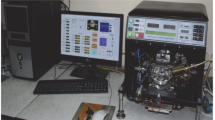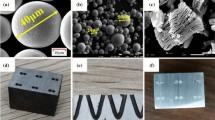Abstract
The friction and wear behaviour of SiC, Si3N4 and SiC/Si3N4 composite ceramics were investigated with oscillating sliding (gross slip fretting) at room temperature. The influence of counter body material and the humidity of the surrounding air was studied with a ball-on-disc configuration with different ball materials (1000Cr6, Al2O3 SiC and Si3N4). The effect of RH on friction is marginal with exception of SiC (low friction) as counter body material. The wear behaviour, however, is strongly affected by humidity, showing inverse trends for different counter body materials. Consequently, the wear behaviour of a tribo couple can be improved by selecting an adequate mating material. The results reveal the necessity to control RH in tribological tests. For estimation of the performance of tribo couples under varying environmental conditions, a variation of RH is required. In tribo couples with single phase SiC, either as ball or disc, the tribological behaviour of the system is dominated by SiC. The friction behaviour of the composite material is in between the behaviour of the two single phase materials, Si3N4 and SiC, whereas the wear behaviour is very similar to that of single phase Si3N4.


















Similar content being viewed by others
References
Czichos, H.: The principles of system analysis and their application to tribology. ASLE Trans. 17, 300–306 (1974)
Sasaki, S.: The effects of the surrounding atmosphere on the friction and wear of alumina, zirconia, silicon carbide and silicon nitride. Wear 134, 185–200 (1989)
Lancaster, J.K.: A review on the influence of environmental humidity and water on friction, lubrication and wear. Tribol. Int. 23, 371–389 (1990)
Klaffke, D.: On the repeatability of friction and wear results and on the influence of humidity in oscillating sliding tests of steel/steel pairings. Wear 189, 117–121 (1995)
Klaffke, D.: Verschleiß in trockener Luft. Tribologie und Schmierungstechnik 44, 219–224 (1997)
Hwang, D.-H., Sung, I.-H., Kim, D.-E., Lee, S.-J.: Effects of material pair properties on the frictional behaviour of metals. Wear 225–228, 600–614 (1999)
Klaffke, D., Scheibe, H.-J., Weihnacht, V.: Tribological characterisation of carbon coatings at room temperature; effect of counter-body material and humidity. Proceedings of 4th The-Coating, pp. 331–340 (2004)
Klaffke, D., Brand, J., Brand, C., Wittorf, R.: Tribological characterisation of a-C:H coatings at room temperature; effect of counter body material. In: Bartz, W.J. (eds.) Proceedings of 14th International Colloquium on Tribology, vol. I, pp. 605–614. TAE, Esslingen (2004)
Klaffke, D., Wäsche, R., Wötting, G.: Tribological characterisation of a Si3N4–TiN composite ceramic in fretting tests at room temperature. In: Bartz, W.J. (ed) Proceedings of 14th International Colloquium on Tribology, vol. III, pp. 1413–1419. TAE, Esslingen (2004)
Klaffke, D., Steinborn, G., Wäsche, R., Wötting, G.: Tribologische untersuchungen an SiC- und Si3N4-basierten keramiken DGM-tagungsband verbundwerkstoffe (Hrsg. H. P. Degischer). Wien, Juli, pp. 545–550 (2003)
Wäsche, R., Klaffke, D., Yarim, R., Santner, E.: Tribological tailoring of ceramic composites. Mat.-wiss. u. Werkstofftech. 34(10–11), 1008–1013 (2003)
Klaffke, D.: On the influence of test parameters on friction and wear of ceramics in oscillating sliding contacts. Tribotest J. 1, 311–320 (1995)
Klaffke, D.: Fretting wear of ceramics. Tribol. Int. 22, 89–101 (1989)
Kostornov, A.G., Panasyuk, A.D., Podchernyaeva, I.A., Umanskii, A.P., Kostenko, A.D.: Composite ceramic materials and coatings for tribologiocal use. Powder Metallurg. Metal Ceram. 42(5,6), 249–256 (2003)
Kajdas, C.: Physics and chemistry of tribological wear. In: Bartz W.J. (ed) Proceedings of 10th International Colloquium on Tribology, pp 1070–1078. TAE, Esslingen (1996)
Wäsche, R., Klaffke, D.: In situ formation of tribologically effective oxide interface in SiC-based ceramics during dry oscillating sliding. Tribol. Lett. 5, 173–190 (1998)
Wäsche, R., Klaffke, D., Woydt, M., Dörfel, I.: Structure of interface in SiC based ceramic composites formed by tribo-oxidation under dry sliding conditions. Ceram. Trans. 146, 401–407 (2004)
Acknowledgements
The assistance of Mrs. Christine Neumann (tribo testing and profilometric measurements) and Mrs. A. Krause (photography) is gratefully acknowledged.
Author information
Authors and Affiliations
Corresponding author
Rights and permissions
About this article
Cite this article
Wäsche, R., Klaffke, D. & Wötting, G. Tribological Behaviour of Structural Si-Based Ceramics in Fretting Tests at Room Temperature. Tribol Lett 33, 211–219 (2009). https://doi.org/10.1007/s11249-009-9413-y
Received:
Accepted:
Published:
Issue Date:
DOI: https://doi.org/10.1007/s11249-009-9413-y




